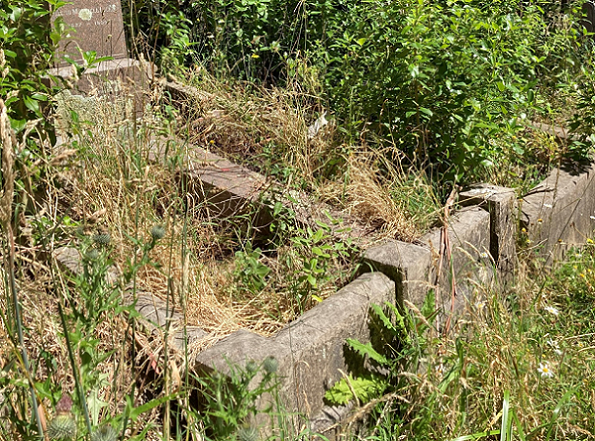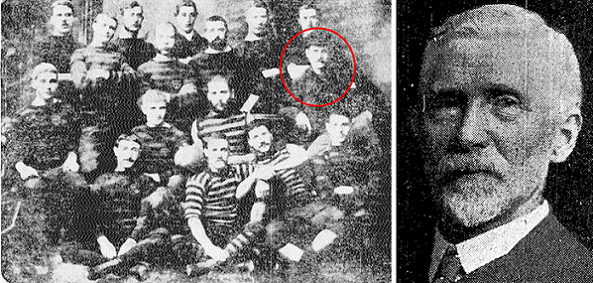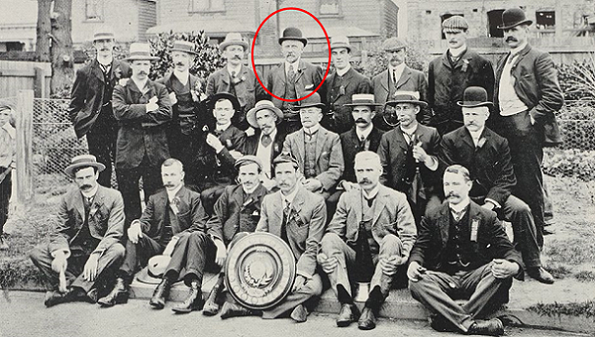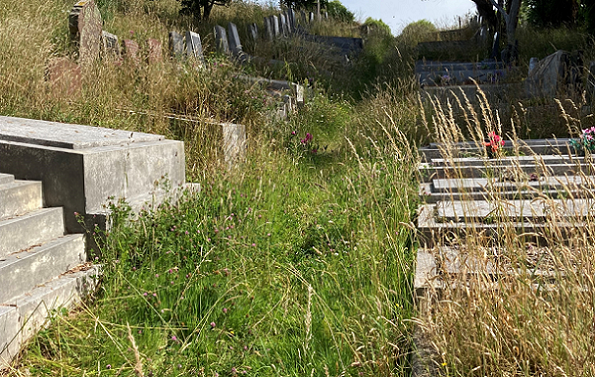A walk among the derelict tombs of the “public” section of Wellington’s Karori Cemetery (New Zealand's second largest burial ground, containing the remains of about 85,000 people), causes one to reflect that the pride of society in its history, can perhaps be seen in the care and maintenance of the monuments created for those who have played a role in building it. After all, memorials are constructed to inform, educate and remind those of the present day, of the lives and exploits (heroic and otherwise), of those who lived in the past.
Among those resting among the roots of the gum trees and gorse bushes now cracking the masonry which houses the remains of Wellington’s deceased citizens, is the collapsed and overgrown memorial to Thomas Sheriff (also known as “Barney”) Ronaldson OBE. The founding chairperson of the Greytown Football Club and captain of the club’s inaugural team in 1879, Barney was once fondly-remembered as “the Father of Rugby in the Wairarapa”, having been responsible for introducing the game to the district in the late 1870’s.

(Barney Ronaldson’s tomb in Karori Cemetery, shared with his wife’s family, the Luckie’s)
At that time, the Wairarapa district was still attached to Wellington, and often Wairarapa players were included in the Wellington representative team. From Greytown, Barney represented Wellington against Otago, Canterbury, and Nelson in 1879. When he moved to Wellington in the early 1880’s, Barney joined the Wellington Football Club. He went to Auckland with the Wellington team which defeated Auckland on 10 September 1880 by 4 points to nil, (the first game played in Auckland between the two provinces). He also represented Wellington against New South Wales in 1882; a match easily won by the Australians by 14 points to 2.

(Ronaldson, circled with the Wellington Football Club team, 1885 club champions)
A member of the now defunct Wellington Cricket Club (which was succeeded by “the Collegians” club), on the cricket field Ronaldson was a good all-rounder, but his forte was bowling. He played for Wellington against the touring 1881 Australian touring eleven at the Basin Reserve and he also represented the Capital against the All-England cricket team at the same venue in 1888. Both matches ended in victories for the tourists.
Ronaldson was at one time president of the Wellington Amateur Athletic Club, and a well-known official at athletic meetings held in Wellington. He was recognised as one of the finest field events judges of the Wellington Amateur Athletic Centre. For many years he was also a member of the Thorndon Bowling Club on Tinakori Road.

(Barney Ronaldson, circled with other officials at the 1904 Wellington athletic championships)
Reminicising on his time as a player, Barney emphasised that if youngsters were "brought up and taught to play the game for the game's sake, there would be very much better football.”
Having earlier lived on the western coast of the North Island, Ronaldson recalled, “when I was in the Rangitikei, if we wanted to play Whanganui, both teams had to go half-way, and we used to meet at Turakina. We would get horses and start off in the morning with, say, thirteen men, hoping to pick up the others on the way. When we got to Turakina we would have to buy a spade, and some five-by-twos and we would mark out the ground and put up the goal-posts.”
In his career as Deputy Public Trustee, Ronaldson was well-respected, with one media wit once noting that Barney was, “as a Public Trustee, “trusty”. He is never cross or crusty, And his brains are never rusty.” Barney became an Officer of the Order of the British Empire (OBE) in 1919 for his services to the Government as Chairman of the Financial Assistance Board, which provided financial grants to members of the New Zealand Expeditionary Force, who without such help would have suffered “undue hardship’ in responding to their country’s call.

(The public section of Wellington’s Karori Cemetery in 2022; a state of despair and disrepair)
There is no doubt that Ronaldson made a significant contribution to his country, in many areas (including community sport), befitting of an appropriate memorial on his death in 1931.
In 1975, the ratepayers of Karori cemetery's eastern suburbs insisted that the local Council plant trees to hide what they considered to be the unpleasant sight of the tombstones from their homes. The act of planting 4,670 trees removed from view the monuments erected to commemorate the lives of Wellingtonians past, including Thomas Sheriff Ronaldson. An unintended (out of sight, out of mind) consequence is that the monuments that remain are in a state of serious disrepair and general dishevelment, which might reflect how important contemporary society considers its early sporting, commercial, cultural and social history to be.
It has been said that “a man is not dead while his name is still spoken”, with tombstones intended to provide the script for those travelling the unkempt paths of Karori Cemetery today. One wonders if those who erected the monument to Barney Ronaldson would have thought their efforts to preserve his memory would be crumbling within a century of his death?